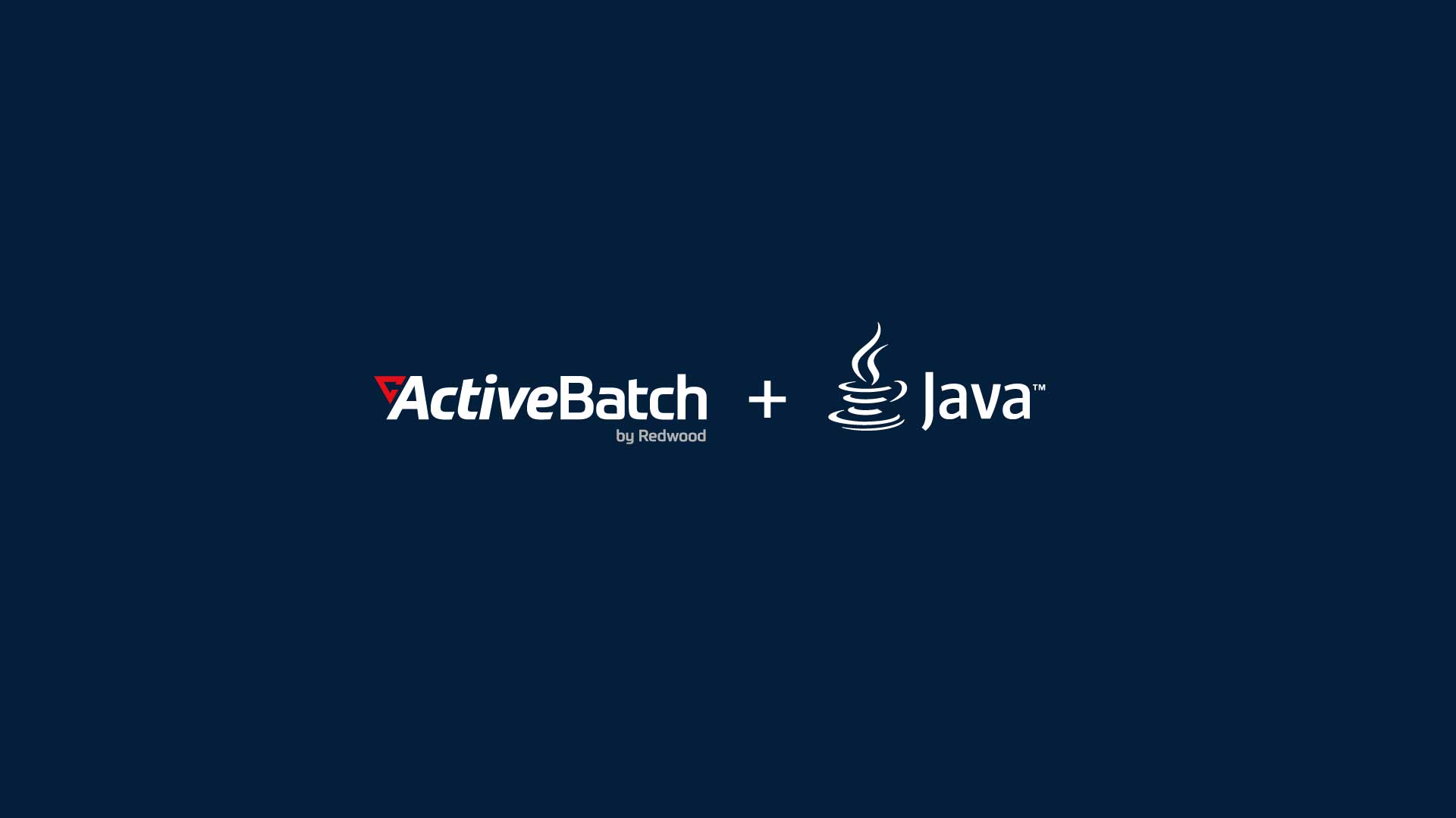Job Scheduling with Java: Understanding Frameworks
Learn about job scheduling with Java, including how to use the Quartz Scheduler, Spring Scheduler, TimerTask, SpringBoot, and more. See how ActiveBatch optimizes Java workflows.

Java has numerous built-in options and frameworks that enable job scheduling with Java applications. Scheduling jobs through Java can be complex and typically requires advanced coding knowledge. However, using job scheduling tools to optimize workflows through automation and orchestration can simplify the process and increase productivity.
Job Scheduling in Java
Java has a built-in scheduling framework called the Java Timer API. This Java scheduler API allows users to schedule tasks for future execution, or to run at specific intervals or at fixed times. The Timer API can be used to run background tasks, process user requests, or perform other system-related functions.
It’s important to note that the Jave Timer API does have some limitations, such as not being suitable for long-running tasks or tasks that require more complex scheduling.
In addition to the Timer API, Java also has other scheduling frameworks like Quartz Scheduler and Spring Scheduler, which offer more advanced features and capabilities for scheduling jobs in a distributed environment. These frameworks support clustering, load balancing, and failover, making them suitable for enterprise applications.
Quartz Scheduler
The Quartz Scheduler is an open source library for job scheduling and management in Java applications. The tool allows developers to schedule and execute jobs for a new date at specific times or intervals.
Quartz uses a robust and flexible scheduling mechanism to specify complex schedules for executing jobs. Exceptions like intervals, delays, and even calendars can be specified for override, and jobs can runnable once, multiple times, or repeatedly. Quartz provides the ability to configure jobs with a parameter or dependency.
Thread pools, cluster management, and job chaining are supported by the Quartz Scheduler, which allows jobs to be scheduled based on the successful completion of other jobs. The library supports integration with various data stores including JDBC and JPA, and provides an API for job monitoring and management.
Spring Scheduler
The Spring Scheduler is a scheduling framework in Java that is built on top of the Quartz Scheduler. It’s part of the Spring Framework (springframework) and provides a simple and flexible way to schedule tasks and jobs in a Java application.
This tool can be easily configured using a XML file or Java annotation and supports multiple scheduling options like cron jobs and cron expression, fixed rate (fixedrate), and fixed delay. The Spring Scheduler is integrated with the Spring Framework (springframework), making it easy to manage a related dependency and connect with other Spring components.
Spring Boot is a very popular framework in Java. Before getting started with creating a scheduled task, users must first implement the scheduling. This starts by creating a Spring Boot application using Spring Initializr. and then by enabling scheduling by adding the @EnableScheduling annotation to the app’s main class.
Creating a Scheduled Task in Java
The process for creating a scheduled task in Java varies significantly based on the scheduler. Here are a few examples of how to create a scheduled task in Java using the Quartz scheduler and TimerTask.
Creating a Scheduled Task with Quartz Scheduler
Before getting started with creating a scheduled task using the Quartz Scheduler, the first step is adding it to the project. If using Maven, the following dependency can be added to the pom.xml file:
<dependency>
<groupId>org.quartz-scheduler</groupId>
<artifactId>quartz</artifactId>
<version>2.3.2</version>
</dependency>Next, create a job by implementing the org.quartz.job interface with the following code:
import org.quartz.Job;
import org.quartz.JobExecutionContext;
import org.quartz.JobExecutionException;
public class MyJob implements Job {
public void execute(JobExecutionContext context) throws JobExecutionException {
System.out.println("Job is running...");
}
}This will create a MyJob class that implements the Job interface and prints a message to the console. The next step is to create triggers that define when the job should be executed.
The above tutorial shows a Scheduler object and JobDetail object that specify the jobs to be executed. The Trigger object specifies when the job should be executed–in this case, every 5 minutes starting at 10:00AM tomorrow.
The withSchedule(cronSchedule("0 0/5 * * * ?")) specifies that the job should be executed using a Cron expression specifying a schedule using a syntax similar to Unix cron jobs. In this case, the Cron expression “0 0/5 * * * ?” specifies that the job should be executed every 5 minutes.
import static org.quartz.CronScheduleBuilder.*;
import static org.quartz.TriggerBuilder.*;
import static org.quartz.DateBuilder.*;
import java.util.Date;
import org.quartz.JobDetail;
import org.quartz.Trigger;
import org.quartz.Scheduler;
import org.quartz.SchedulerFactory;
import org.quartz.impl.StdSchedulerFactory;
public class SchedulerExample {
public static void main(String[] args) throws Exception {
SchedulerFactory sf = new StdSchedulerFactory();
Scheduler sched = sf.getScheduler();
JobDetail job = newJob(MyJob.class)
.withIdentity("myJob", "group1")
.build();
Date startTime = tomorrowAt(10, 0, 0);
Trigger trigger = newTrigger()
.withIdentity("myTrigger", "group1")
.startAt(startTime)
.withSchedule(cronSchedule("0 0/5 * * * ?"))
.build();
sched.scheduleJob(job, trigger);
sched.start();
}
public static Date tomorrowAt(int hour, int minute, int second) {
return DateBuilder
.tomorrowAt(hour, minute, second)
.build();
}
}Creating a Scheduled Task with TimerTask
is executed by a demon thread. With this method, a delayed task will delay other tasks in the schedule, so it’s not a viable option for scheduling multiple tasks at the same time.
Here is an example of using TimerTask to create a scheduled task in Java:
import java.util.Timer;
import java.util.TimerTask;
public class ScheduledTaskExample {
public static void main(String[] args) {
Timer timer = new Timer();
// Create a task to be scheduled
TimerTask task = new TimerTask() {
public void run() {
System.out.println("Scheduled task is running.");
}
};
// Schedule the task to run after a delay of 5 seconds
timer.schedule(task, 5000);
// Schedule the task to run repeatedly after an interval of 10 seconds
timer.schedule(task, 10000, 10000);
}
}
In the above example, a Timer object is created first. The Timer object is used to schedule and execute TimerTask objects. Next, a TimerTask object is defined by implementing the run() method that contains the code needed to execute the scheduled task.
This example is using the schedule() method of the Timer object to schedule the task to run after a delay of 5 seconds, and then run repeatedly after an interval of 10 seconds. After running this code, users should see the message: “Scheduled task is running.” printed to the console every 10 seconds.
ActiveBatch Java Job Scheduler
For teams working with Java applications, ActiveBatch offers a cross-platform job scheduling solution to automate and orchestrate processes. An event-driven architecture provides advanced scheduling features and capabilities that reduce delays.
Teams can minimize manual intervention with event triggers like email, file events, FTP file triggers, and data modifications. The Integrated Jobs Library offers hundreds of platform-agnostic job steps.
IT professionals can quickly build, automate, and initialize workflows with ActiveBatch’s seamless integrations. Connections with business process automation tools like Microsoft app suite, including GitHub and ERP systems, and data warehousing tools like Hadoop, SAP, Oracle, Informatica, IBM, and other open source software, makes it easy to add ActiveBatch to your existing tech stack.
Frequently Asked Questions
There are several job schedulers available for Java, each with unique benefits and challenges. Selecting which is best depends on the specific requirements of the Java application in question. In addition to the Quartz Scheduler and Spring Scheduler, Timer and JavaScheduledExecutorService are other methods for job scheduling with Java.
Timer is a simple and lightweight scheduler that is part of the Java Standard Library. It’s easy to use and offers basic scheduling capabilities like delays and intervals, but lacks advanced features like clustering and high availability.
Java ScheduledExecutorService is another simple and lightweight scheduler that is part of the Java Standard Library. It offers basic scheduling capabilities, such as delays and intervals, and supports asynchronous job execution. However, it lacks advanced features such as clustering and failover.
Java ScheduledExecutorService is part of the Java Standard Library and is also more simple and lightweight than the Quartz or Spring schedulers. In addition to supporting delays and intervals, Java ScheduledExecutorService supports asynchronous job execution. It also lacks clustering and failover.
See why ActiveBatch is the best cross-platform job scheduling software for enterprises.
Here are a few common approaches for how to set the scheduler time in Java using different scheduler libraries.
Quartz Scheduler
In Quartz Scheduler, the scheduler time is set using a cron expression. A cron expression is a string that defines a schedule by specifying the minute, hour, day of the month, month, and day of the week.
In the below tutorial, the cron expression represents a schedule that runs every day at 3:30 AM:0 30 3 * * ?
Timer Scheduler
With the Timer Scheduler, The scheduled time is set by creating a TimerTask object and scheduling it to run after a delay or at a fixed rate. The following code will schedule a task to run after a delay of 5 seconds:Timer timer = new Timer();TimerTask task = new TimerTask() { public void run() { System.out.println("Task is running..."); }};timer.schedule(task, 5000);
Teams use ActiveBatch’s job scheduling software to centralize workflows for both Windows and non-Windows applications.







